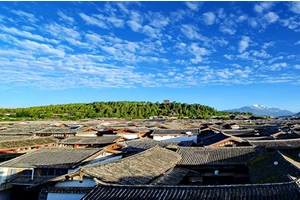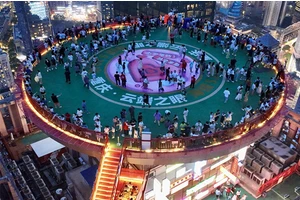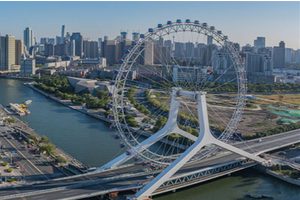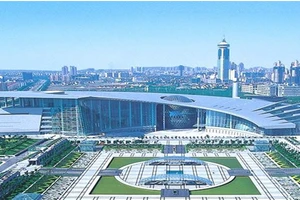Jiuhuashan map tourist map
1. Where is Jiuhua Mountain in Henan? 2. Where is Jiuhua Mountain in Chifeng? 3. Detailed map of Jiuhua Mountain Scenic Area by car during the Spring Festival? 4. Map location of Mount Emei, Mount Wudang, Mount Qingcheng, Mount Putuo and Jiuhua Mountain? Where is Jiuhua Mountain in Henan?
Question 1: Where is Jiuhua Mountain? How come there are Anhui and Henan? That's fun! There is no Jiuhua Mountain in Henan. I belong to Jiuhua Mountain, and now I am in Henan.
Jiuhua Mountain, the first batch of national key scenic spots and a famous summer resort, is now a national 5A-level tourist area and a demonstration site of national civilized scenic spots. Together with Wutai Mountain in Shanxi, Putuo Mountain in Zhejiang and Emei Mountain in Sichuan, Jiuhua Mountain is also known as the four famous Buddhist mountains in China. It is a great wish of "The Buddha Dojo of the Tibetan King and Bodhisattva can be proved by all living beings" and is known as the international Buddhist Dojo. Located in Qingyang County, Chizhou City, Anhui Province.
It is wrong to say that Jiuhua Mountain is located in Anyang County, Henan Province. It is estimated that Qingyang, Anhui Province has been turned into Anyang, Henan Province.
Question 2:? Where is Jiuhua Mountain? Jiuhua Mountain, known as Lingyang Mountain and Jiuzi Mountain in ancient times, is one of the "four famous Buddhist mountains in China". It is located in Qingyang County, Chizhou City, Anhui Province, and is known as the "first mountain in the southeast". It is said that due to the poem "Looking at Jiuhua as a gift to Qingyang Wei Zhongkan" written by Li Bai in the Tang Dynasty, "Yesterday I was on Jiujiang, looking at Jiuhua Peak in the distance. Tianhe hangs green water and shows nine hibiscus. " It was renamed "Jiuhua Mountain". Jiuhua Mountain, Chizhou City, Anhui Province, is a national 5A-level tourist attraction.
Question 3: What is the difference between Yeji Jiuhua Mountain in Henan Province and Jiuhua Mountain Scenic Area in Anhui Province? Jiuhua Mountain is Mahayana Buddhism, and those are all Mahayana Buddhism. Jiuhua Mountain is known as the Great Jiuhua Mountain, and others can only be called the Small Jiuhua Mountain. Independent of each other, independent of each other.
Question 4: Where is Jiuhua Mountain? There are many Jiuhua Mountains.
Jiuhua Mountain (Jiuhua Mountain, Chizhou City, Anhui Province, a national 5A-level tourist attraction)
Jiuhua Mountain, known as Lingyang Mountain and Jiuzi Mountain in ancient times, is one of the "four famous Buddhist mountains in China". It is located in Qingyang County, Chizhou City, Anhui Province, and is known as the "first mountain in the southeast". It is said that due to the poem "Looking at Jiuhua as a gift to Qingyang Wei Zhongkan" written by Li Bai in the Tang Dynasty, "Yesterday I was on Jiujiang, looking at Jiuhua Peak in the distance. Tianhe hangs green water and shows nine hibiscus. " It was renamed "Jiuhua Mountain".
Jiuhua Mountain (Jiuhua Mountain in Xuanwu District, Nanjing (covering Zhoushan))
Jiuhua Mountain, also known as Fu Zhoushan Mountain and Xiao Jiuhua Mountain, is located on the west side of Taiping Gate in Xuanwu District, Nanjing. It is the first hill where the remaining pulse of Zhongshan goes west into the city. It is separated from the Ming City Wall in the north and adjacent to Xuanwu Lake. There are temples in the mountain, towers on the top, lakes on the side of the mountain and cities under the mountain.
Jiuhua Mountain (West Jiuhua Mountain, Gushi County, Henan Province)
West Jiuhua Mountain is located in the southeast of Gushi County, a directly administered county in the southeast corner of Henan Province. It belongs to the middle part of Dabie Mountain range and is a national AAAA scenic spot with an ornamental area of 80 square kilometers. It is the largest eco-tourism resort in the Central Plains that integrates tea, bamboo, Zen and mountain water.
Jiuhua Mountain (Jiuhua Mountain, Quzhou City, Zhejiang Province)
Jiuhua Mountain, formerly known as Big Monkey Mountain, also known as Qi Tianshan Mountain, is located 15 kilometers northwest of Quzhou City, which is a densely populated area of tourism resources in Quzhou City, Zhejiang Province. Quzhou is a famous historical mountain with nine famous peaks. It is a summer resort in Quzhou and a Buddhist activity center in western Zhejiang.
Jiuhuashan (Jiuhuashan, Huxian County, Shaanxi Province)
Jiuhua Mountain is located on Zhongnan Mountain, 20 kilometers south of Huxian County, Shaanxi Province, with an altitude of 1766.4 meters. Located between Tanyu River, Baoyugou, Zhuyu and Zaoyu Gounao, it belongs to the boundary of Shijing Town. According to Wu Jizu's "Rebuilding the Records of Huxian County" in 22 years of the Republic of China, "There are four temples at the top of the mountain, with the Lingguan Hall at the top, the Lingyun Tower at the bottom, the middle hall at the top, the Yujing Pool at the top, and the tiger-planed spring at the third hall, and the Buddha cave and the stone cliff at the right. Then there is the back hall, the silver and copper ditch in the west, and the situation is steep. On the top of the hall, over the ditch, there is the Nantianmen. According to legend, the foot of the mountain is pure and empty, and there is a fire burning in the Buddha cave, and its smoke comes out of the temple every three floors. "
Jiuhua Mountain (Jiuhua Mountain, Putian City, Fujian Province)
Jiuhua Mountain is located at the junction of Xitianwei Town and Changtai Town, 10 kilometers northwest of Licheng. It is the main peak of Beigan Mountain, with an altitude of 741 meters. It faces Hugong Mountain in the south of Licheng and is also a famous mountain on the side of Xinghua Plain.
Jiuhua Mountain (Jiuhua Mountain, Fengyang County, Anhui Province)
Located in Chizhou City, Anhui Province, Jiuhua Mountain is a mountain-type national scenic spot featuring Buddhist culture and natural and humanistic scenery. It is one of the four famous Buddhist mountains in China, the first batch of 5A-level tourist attractions in China, the first batch of natural and cultural heritage sites in China, and the main scenic spot of the tourism development strategy of "two mountains and one lake" (Jiuhua Mountain, Taiping Lake and Huangshan Mountain) in Anhui Province. The scenic spot has a planned area of 120 square kilometers and a protected area of 174 square kilometers, and consists of 11 major scenic spots.
Jiuhua Mountain (Jiuhua Mountain, Anyang City, Henan Province)
Jiuhua Mountain is located in the northwest of Xujiagou Village, 27.5 kilometers west of Anyang County, Anyang City, Henan Province, and southwest of Guanjiazhuang Village.
Question 5: When the West Jiuhua Mountain is clear in China, you must go to Liumeng Valley Landscape Gallery. In spring, a variety of wild orchids quietly open in the valley, with an empty valley and elegant fragrance; A tree on the rock is in full bloom in the wind, like red clouds floating in the valley, which is the essence of the natural landscape of West Jiuhua Mountain
Question 6: How many kilometers does it take to drive from Zhengzhou to Jiuhua Mountain in An Wei? Depart from Zhengzhou, pass Zhengzhou -G4 Beijing-Hong Kong-Macao Expressway -G36 Ningluo Expressway -S12 Chuxin Expressway -S17 Banghe Expressway -G3 Jingtai Expressway-Chizhou, and arrive at Jiuhua Mountain Scenic Area. The whole journey is 774.0 kilometers. According to the current road conditions, it is estimated that it will take 8 hours and 18 minutes. I suggest you download a Tencent map route query function, which can provide taxi bus self-driving and multiple route queries. This is the shortest self-driving route, and it supports bus driving in rental price, 210 cities and nearly 400 cities in China. Download a Tencent and check it carefully.
Question 7: How to drive from Zhoukou City, Henan Province to Jiuhua Mountain, Anhui Province? How far is it? The whole journey from Zhoukou City to Jiuhuashan Scenic Area is about 611.4 kilometers. 1. The driving scheme in Zhoukou City is abbreviated.
2. Enter S238
3. Drive along S238 for 20.6 kilometers and turn right.
4. Drive 60 meters and turn right ahead.
5. Drive 640 meters and go straight.
6. Drive for 400 meters, head for Jieshou/Nanjing, and turn right slightly.
7. Drive 680m and enter G36 from the entrance.
8. Drive along G36 for 104.2km, head for Fuyang/Lu 'an/Jingdezhen /G35, turn right slightly and enter into Liu Xiaoji Hub.
Full road toll
View service area
9. Drive along Liu Xiaoji Hub for 1.1km, and enter G35 from the entrance at Liu Xiaoji Hub.
Full road toll
10. Drive along G35 for 42.0km, head for Hefei/Huainan/Linquan/Xincai, turn right slightly and enter Sishipu Hub.
Full road toll
11. Drive along Sishipu Hub for 360m, cross Dazhaozhuang towards Hefei/Huainan, and turn left slightly.
Full road toll
12. Continue to drive along Sishipu Hub for 1.4 kilometers and enter Chuxin Expressway from the entrance.
Full road toll
13. Drive along Chuxin Expressway for 105.0km and go straight into Banghe Expressway.
Full road toll
14. Drive along Banghe Expressway for 64.9 kilometers, head for Hefei West/Hefei South/Anqing/Tongling, turn right slightly and enter G40.
Full road toll
15. Drive along G40 for 31.2km, head for Tongling/Anqing /G3/G4212, turn right slightly and enter Xiaoxichong Hub.
Full road toll
16. Drive along Xiaoxichong Hub for 860m, and enter G4212 from the entrance at Xiaoxichong Hub.
Full road toll
17. Drive along G4212 for 60.9 kilometers, head for Tongling/Huangshan, turn right slightly and enter G3.
Full road toll
18. Drive along G3 for 74.1km and go straight to S103.
Full road toll
19. Drive along S103 for 3.8km and go straight into G3.
20. Drive along G3 for 57.2km and leave at Lingyang/Shitai exit.
Full road toll
21. Drive for 1.1km, turn left slightly in the direction of Lingyang.
22. Chizhou City Driving Scheme
details
1) Drive 50 meters and turn left.
2) Drive for 3.1km and turn left slightly.
3) Drive 480m and go straight to X030.
4) Drive along X030 for 8.8km and turn right ahead.
5) Drive 110m and go straight.
6) Drive for 1.4km and turn right ahead.
7) Drive for 16.0km, turn left slightly and enter S219.
8) Drive 5.8km along S219 and reach the destination Jiuhuashan Scenic Area.
Question 8: What is the specific address of West Jiuhua Mountain? Xijiuhua Scenic Area, Chenlinzi Town, Gushi County, Xinyang City, Henan Province
Question 9: What places in Henan have good scenery? Among the "Eight Ancient Capitals of China", there are four in Henan: Zhengzhou, Luoyang, Kaifeng and Anyang. They are all famous tourist cities in Henan.
Songshan, located near Dengfeng, is the middle of the five mountains.
Shaolin Temple-located in Songshan, the birthplace of Shaolin martial arts.
Longmen Grottoes-Near Luoyang, it was listed as a world cultural heritage by the United Nations in 2000.
Baima Temple-Near Luoyang, it is the first temple built by the government after Buddhism was introduced into China, and it occupies an important historical position in the history of Buddhism in China.
Jigong Mountain-a famous summer resort located in the southern provincial boundary.
Jiuhua Mountain-a famous Buddhist mountain in the southeast province.
Huayang Buddha Mountain-a famous Buddhist mountain located in the southeastern province.
Qingfeng Mountain-a famous Taoist mountain located in the border of southeast province.
Huanggu Mountain-a famous mountain located in the border of southeast province.
Huazhou Academy-located in Dengzhou, is the birthplace of Fan Zhongyan's Yueyang Tower.
Lei Feng Tuan Memorial Hall-located in Dengzhou, is an educational base for the Party and the people to learn and cultivate patriotism.
Yin Ruins, the capital of Shang Dynasty, now has a museum.
Shirenshan-Shirenshan Scenic Area is located in the west of Lushan County, Pingxiang City, Henan Province, and in the east of Funiu Mountain, with a total area of 268 square kilometers, and the main peak Yuhuangding is 2153.1 meters above sea level. Shiren Mountain was called Yaoshan in ancient times, and it was named after Yao Sun and Liu Lei who set up Yao Temple for ancestor worship. During the Warring States Period, Mo Zhai, a great thinker and social activist, was born at the foot of Yaoshan Mountain.
Luoyang Peony-Luoyang is the hometown of China Peony, and Luoyang Peony Festival is held every May when the peony is in full bloom. According to legend, Wu Zetian banished all the peonies from Chang 'an to Luoyang, so she took root in Luoyang and was cultivated by Wei, Yao and other families in Luoyang into various new varieties, such as "Wei Zi Yao Huang", which developed and expanded in Luoyang.
Henan Museum-The museum was formerly the Henan Museum in Kaifeng initiated by Feng Yuxiang in 1927. In the 1990s, a new museum was built in Zhengzhou. After the merger of the Central Plains Stone Carving Art Museum and the Henan Provincial Museum, it was named' Henan Museum'.
Question 10: What are the interesting places in Henan? Go to Luoyang to see peony in spring (April), Luanchuan in Luoyang in summer, Baiyun Mountain, Chongdugou, Tianchi Mountain and Yuntai Mountain in Jiaozuo to cool off the summer, and visit Kaifeng to see chrysanthemums in autumn. By the way, visit Long Ting and Sokokuji, and ski in Funiu Mountain in Luoyang in winter.
Xinyang:
Nanwan Reservoir, the first lake in the Central Plains, is a national forest park. It is located in the center of negative worry, upstream of the lake, and there are Wuyun (Cheyun Mountain, Jiyun Mountain, Yunwu Mountain, Tianyun Mountain and Lianyun Mountain) and Liangtan (Black Dragon Pool and Bailongtan). Xinyang Maojian Tea is the most authentic in these five places.
Jigong Mountain, one of the four major summer resorts in China, is famous for its beautiful scenery and strange peaks and rocks all over the mountain.
Jiuhua Mountain Scenic Area is located in Chenlinzi Town. It belongs to the transition area from subtropical zone to warm temperate zone, with climate.
Jingangtai National Geopark, surging the Huaihe River, gave birth to a beautiful historical story, towering Dabie Mountain, creating a magic everywhere.
Tangquanchi scenic spot is a famous hot spring convalescence and mountain scenic spot in Henan Province.
In addition, there are Lingshan Temple, Jingju Temple, Xianyin Temple, Shangtian Ladder and Dongzai Forest Farm.
Zhengzhou:
Songshan Shaolin Scenic Area, Dengfeng Zhongyue Temple, Yellow River Tourist Area, Century Happy Garden, Songyang Academy, Gongyikang Million Manor, Xinzheng Huangdi Hometown, Gaocheng Town Stargazing Platform, Yellow River Tourist Area, Song Ling (Seven Emperors and Eight Mausoleums), Huangdi Hometown.
Shizu Mountain, known as Juci Mountain in ancient times, is located in Qianhuzhai, 15 kilometers southwest of xinzheng city, with picturesque scenery and cultural relics of the Yellow Emperor all over Shan Ye. From a distance, the main peak of Shizu Mountain looks like a statue of Xuanyuan Huangdi, which is majestic and awe-inspiring. Cliffs and cliffs, with strange peaks and rocks, constitute a high and majestic mountain scenery. The hillside is densely forested, and the Qinggangmiao Reservoir, which is halfway up the mountain, is as level as a mirror and crystal clear. On the west slope, the Black Dragon Pool and the Jade Girl Pool, with their streams gurgling and sparkling, are charming and moving, forming a beautiful scenery in which mountains, water, springs and forests are integrated.
Mangshan Ancient Tree Garden: Located at the intersection of Tianhe Road and Kaiyuan Road, it covers an area of 600 mu, with 3,723 trees planted, including 880 ancient trees, 3 trees over 1,000 years old, dozens of trees over 500 years old and 850 trees over 100 years old. There are also forest paths, two boulders weighing 60-80 tons, artificial lakes and rockeries.
Luoyang:
Longmen Grottoes in Luoyang, Baima Temple, National Peony Garden, Guanlin Scenic Area, longyuwan national forest park, Jiguandong Scenic Area, Songxian Baiyun Mountain National Forest Park, Luanchuan Chongdugou Scenic Area, Laojunshan Nature Reserve and Lingshan Temple.
Kaifeng:
Kaifeng Qingming Shangheyuan, Baogong Temple, Long Ting Park, Sokokuji, Fujian Scenic Area, Tower Park, China Hanyuan Forest of Steles, Long Ting, Kaifeng House, Kaifeng Tower, Tianbo yangfu, Yuwangtai, Baogong Temple, Kaifeng Fanta, Yanqing Temple and Jinmingchi.
Kaifeng House-the capital of the Northern Song Dynasty, visit the Imperial Palace of the Six Dynasties.
Long Ting, the main venue of Kaifeng Chrysanthemum Flower Festival.
Grand Sokokuji, a thousand-year-old temple, is a famous temple with outstanding status and extensive influence in the history of Buddhism in China.
Qingming Shanghe Garden is a large-scale folk custom amusement park in Song Dynasty, which reproduces the original landscape. The main buildings include the city gate building, Hongqiao, street view, shops, rivers, docks, boathouses and so on. According to the original layout of the Riverside Scene at Qingming Festival, the park focuses on the on-site production of restaurants, tea shops, pawn shops, Bianxiu, official porcelain and New Year pictures in the Song Dynasty. Gather folk entertainment, acrobatics and drum performances; God teaches fortune telling, gambling, cockfighting, dog fighting and other Kyoto customs.
The Shan-Shan-Gan-Gu Guild Hall can see some stone carvings, wood carvings and brick carvings, listening to the story told by the commentator.
Tower Park: The tower was built in 1043 (the first year of the Northern Song Dynasty), with a height of 55.63 meters and 13 floors. It was the symbol of ancient Kaifeng (Bianliang). Because the tower body is all inlaid with brown glazed tiles, it looks like iron color from a distance, so it is called the "tower". The tower body is covered with patterned bricks, and there are flying, unicorn, bodhisattva and so on.
The po Tower, because of the rising terrain of Kaifeng City and its destruction, has only three floors left. Some locals say, "The tower is high, the tower is high, and no matter how high it is, it is not as high as the Po Tower", which shows that the ancient Po Tower is still quite high.
There are many old buildings in the old campus of Henan University.
There are many food stalls in Gulou Square at night.
Chrysanthemum Flower Show: From October 28th to November 28th, at this time every year, colorful chrysanthemums, red, yellow, purple and white, are all over the streets of Kaifeng, decorating Kaifeng into a sea of flowers. The main exhibition spots of the flower show are Long Ting, Iron Tower, Sokokuji, Baogong Temple, Yuwangtai and so on. There are more than 100 kinds of chrysanthemums on display. ......
In which direction is Jiuhua Mountain in Chifeng?
Southwest direction.
Jiuhua Mountain, known as Lingyang Mountain and Jiuzi Mountain in ancient times, is one of the four famous Buddhist mountains in China. It is located in Qingyang County, Chizhou City, Anhui Province, and is known as the first mountain in the southeast.
Chifeng, formerly known as Zhaowu Damon, is a prefecture-level city under the jurisdiction of Inner Mongolia Autonomous Region. It is located in the southeast of Inner Mongolia, at the intersection of Mongolia, Hebei and Liaoning provinces, bordering Chaoyang in the southeast, Chengde in the southwest, Tongliao in the east and Xilin Gol League in the northwest. From the map of China, we can see that Jiuhua Mountain is in the southwest of Chifeng.
Detailed explanation of the map of Jiuhuashan scenic spot by car during the Spring FestivalDriving route: The whole journey is about 210.9 kilometers.
Starting point: Anhui Province
1. Driving scheme in Anhui Province
1) Start from the starting point in the east direction, drive along the middle Yangtze River Road for 1.4 kilometers, pass Yong Men Bridge, and turn right into Maanshan Road.
2) Drive along Ma 'anshan Road for 370 meters, cross Liufang Bridge, head for North-South No.1 Elevated Road/South Second Ring Road, turn right slightly and enter North-South No.1 Elevated Road.
3) Drive 4.5km along the North-South No.1 elevated road and go straight into Maanshan Road.
4) Drive along Ma 'anshan Road for 210 meters, cross Ma 'anshan Road and Bridge on the Second Ring Road, turn left slightly and enter Baohe Avenue.
5) Drive along Baohe Avenue for 1.6 kilometers, turn right ahead and get on the ramp.
6) Drive along the ramp for 980 meters and go straight into Beijing-Taiwan Expressway.
7) Drive along the Beijing-Taiwan Expressway for 1.4km, head for Tongling/Fuzhou/Anqing /G3, turn right slightly and enter the Beijing-Taiwan Expressway.
8) Drive along Beijing-Taiwan Expressway for 1.0km, pass Xiaoxichong Hub for about 270m, and then go straight into Beijing-Taiwan Expressway.
9) Drive 5.6 kilometers along Beijing-Taiwan Expressway and go straight into He 'an Expressway.
10) Drive 20 meters along He 'an Expressway and go straight into Beijing-Taiwan Expressway.
11) Drive along Beijing-Taiwan Expressway for 2.0km and go straight into He 'an Expressway.
12) Drive along He 'an Expressway for 740m, turn right slightly and enter Beijing-Taiwan Expressway.
13) Drive 6.1km along Beijing-Taiwan Expressway, cross Zhongpaihe Bridge and go straight into Beijing-Taiwan Expressway.
14) Drive 400 meters along Jingtai Expressway and go straight into He 'an Expressway.
15) Drive along He 'an Expressway for 4.9 kilometers, turn right slightly and enter Beijing-Taiwan Expressway.
16) Drive along Beijing-Taiwan Expressway for 1.3km and go straight into He 'an Expressway.
17) Drive 1.5km along He 'an Expressway and go straight into Beijing-Taiwan Expressway.
2. Drive along Beijing-Taiwan Expressway for 10.0km, turn right slightly and enter Beijing-Taiwan Expressway.
3. Drive along Beijing-Taiwan Expressway for 20.8km and go straight into He 'an Expressway.
4. Drive 780m along He 'an Expressway and go straight into Beijing-Taiwan Expressway.
5. Drive along Beijing-Taiwan Expressway for 1.7 kilometers and go straight into He 'an Expressway.
6. Drive 4.5km along He 'an Expressway, head for Tongling/Huangshan/Fuzhou/Jiuhuashan, turn right slightly and enter Beijing-Taiwan Expressway.
7. Drive 74.1 kilometers along the Beijing-Taiwan Expressway and go straight into the Beijing-Taiwan Expressway.
8. Drive along Beijing-Taiwan Expressway for 50 meters and go straight to S103.
9. Chizhou City Driving Scheme
1) Drive along S103 for 3.8km and go straight into Beijing-Taiwan Expressway.
2) Drive along the Beijing-Taiwan Expressway for 310 meters and go straight into the Beijing-Taiwan Expressway.
3) Drive along Beijing-Taiwan Expressway for 19.6 kilometers and go straight into Qingshan Tunnel.
4) Drive along Qingshan Tunnel for 680m and go straight into Beijing-Taiwan Expressway.
5) Drive along Beijing-Taiwan Expressway for 3.9 kilometers, at Qingyang/Jiuhuashan exit, turn right slightly and get on the ramp.
6) Drive along the ramp for 830m, turn right ahead and enter G318.
7) Drive along G318 for 310 meters and go straight into G318.
8) Drive along G318 for 520 meters, take the first exit, turn right in the direction of Chizhou/Jiuhuashan /G318 and enter G318.
9) Drive along G318 for 11.5 kilometers, after passing Jiaocun on the right for about 100 meters, turn right slightly in the direction of Jiuhuashan Geopark and enter Wuxi Interchange.
10) Drive along Wuxi Interchange for 920 meters, cross Wuxi Bridge, head for Jiuhua Mountain, and go straight.
11) Drive 100 meters, cross Wuxi Bridge, take the first exit, turn left and enter S219.
12) Drive 5.7 kilometers along S219, pass the Gree Electric national 4S chain store NO.Wan R0886 on the right for about 130 meters, and then go straight into Foguang Avenue.
13) Drive along Foguang Avenue for 1.3km, turn right slightly and enter Jiuhua Avenue.
14) Drive along Jiuhua Avenue for 4.3 kilometers and turn left.
15) Drive 220 meters, turn right and enter S219.
16) Drive along S219 for 9.8km and reach the destination (on the right side of the road).
End point: Jiuhuashan Scenic Area
Map locations of Mount Emei, Mount Wudang, Mount Qingcheng, Mount Putuo and Mount JiuhuaThey are all maps of Jiuhua Mountain in China!
Splendid Jiangshan, the Three Gorges of the Yangtze River (Qutang Gorge, Wuxia Gorge and Xiling Gorge) show the ingenuity of nature; The four major Foshan (Wutai Mountain, Emei Mountain, Putuo Mountain and Jiuhua Mountain) are the treasures of Buddhist culture. The four Taoist mountains (Heming Mountain, Longhu Mountain, Wudang Mountain and Qiyun Mountain) bear the mystery and wisdom of Taoism. The four famous springs (Beijing Yuquan, Jinan Baotu Spring, Zhenjiang Zhongling Spring and Wuxi Huishan Spring) have their own characteristics and are beautiful.
The five mountains (Mount Tai in Dongyue, Mount Huashan in Xiyue, Songshan in Zhongyue, Hengshan in Beiyue and Hengshan in Nanyue) stand proudly and witness the historical changes. The five major towns and mountains (Yishan, Wu Shan, Tianzhu Mountain, Huiji Mountain and Yiwulu Mountain) each guard the safety of one side. The five famous mountains (Huangshan, Lushan, Qingcheng, Wuling and Wuyishan) are beautiful and attract countless tourists.
Five famous lakes (Poyang Lake, Dongting Lake, Taihu Lake, Hongze Lake and Chaohu Lake) are embedded in the land of China like pearls. China's World Heritage List is rich and varied, including World Cultural Heritage (21 places), World Natural Heritage (4 places), World Cultural and Natural Heritage (4 places), Cultural Landscape (1 place), Oral Heritage of Human Beings and Intangible Heritage Representatives (2 places).
Famous historical and cultural cities (24 in the first batch and 38 in the second batch) bear the historical memory of the Chinese nation. The three grottoes in the architectural world (Longmen Grottoes, Yungang Grottoes and Dunhuang Mogao Grottoes) show the outstanding achievements of ancient sculpture art. Three famous bridges (Anji Bridge in Zhaozhou, Guangji Bridge in Chaozhou and Luoyang Bridge) bear witness to the wisdom of bridge architecture in China.
The three ancient buildings (Forbidden City, Daimiao Temple in Mount Tai and Confucius Temple in Qufu) bear the treasures of Chinese civilization. The three famous buildings (Tengwangge, Yellow Crane Tower and Yueyang Tower) have their own characteristics and are famous all over the world. The four academies (Yuelu Academy, Shigu Academy, Bailudong Academy and Yingtianfu Academy) are the centers of ancient learning.
The four famous pavilions (Zuiweng Pavilion, Huxin Pavilion, Taoran Pavilion and Love Evening Pavilion) bear the elegant charm of poets and poets. Four famous pavilions (Tianyi Pavilion, Wenhui Pavilion, Wenzong Pavilion and Wenlan Pavilion) witnessed the prosperity of Chinese book culture. The four courtyards in the Qing Dynasty (Wenyuan Pavilion, Wenyuan Pavilion, Wenjin Pavilion and Wenshui Pavilion) represent the glory of the Royal Library.
The four forests (qixia temple in Nanjing, kokuseiji in Tiantai, Lingyan Temple in Shandong and yuquan temple in Hubei) are holy places of Buddhist culture. The six monasteries of Gelug Sect of Lamaism (Ta 'er Monastery, Gandan Monastery, drepung monastery, Sera Monastery, Labrang Monastery and Tashilhunpo Monastery) show the charm of Tibetan Buddhism.
The seven ancient capitals (Beijing, Xi 'an, Luoyang, Kaifeng, Nanjing, Hangzhou and Anyang) bear the development course of Chinese civilization. The seven famous cities (Tungsten Capital, Antimony Capital, Yandu Capital, Tao Dou Capital, Porcelain Capital and Steel Capital) have their own characteristics, showing the brilliance of China's industry.
Nine famous customs (Shanhaiguan, Juyongguan, Zijingguan, Niangziguan, Pingxingguan, Yanmenguan, Jiayuguan, Wushengguan and Youyiguan) stick to the frontier of the motherland. The four famous gardens of garden ecology (Summer Palace, Humble Administrator's Garden, Lingering Garden and Summer Resort) show the charm of Chinese garden art.
The three famous horses (Sanhema, Hail Hequ Horse and Ili Horse) are the treasures of equestrian culture in China. Plum blossoms in the three plum gardens (Wuxi Meiyuan, Suzhou Dengwei Mountain and Hangzhou Fanghe Pavilion) are full of fragrance.
Cultural, artistic and cultural cities (Beijing, Chengde, Datong, Nanjing, Suzhou, Yangzhou, Hangzhou, Shaoxing, Quanzhou, Qufu, Luoyang, Kaifeng, Jiangling, Changsha, Guangzhou and Guilin) bear the cultural heritage of the Chinese nation. Ancient sites (Zhoukoudian site, Ding Cun site, etc.) bear witness to the development of human beings.
Famous songs (high mountains and flowing water, Guangling San, etc.) inherit the music culture of the Chinese nation. Ten tragedies (Dou E's injustice, etc.) reveal social injustice and human tragedy. The top ten comedies (saving the wind and dust, etc.) show the variety and joy of life.
The top ten military books (Sun Tzu's Art of War, etc.) record the wisdom of ancient military affairs. Song Di's Eight Scenes (Pingsha Wild Goose, etc.) depict the beauty of natural scenery. The best of the long couplets (Linjiang Tower, etc.) shows the charm of poetry.
This tour map of China is not only an overview of China's tourism resources, but also the inheritance and development of Chinese national culture. I hope this map can provide you with a reference in your travel, so that you can gain something and feel when you visit the great rivers and mountains of the motherland.






